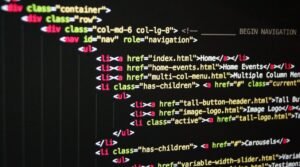Artificial Intelligence Framework: Unlocking the Power of AI
Artificial Intelligence (AI) has not only revolutionized many industries but also transformed the way we live and work. From virtual assistants to automated systems, AI offers countless opportunities for innovation and efficiency. Behind the scenes, AI frameworks play a crucial role in enabling developers to create powerful AI applications. In this article, we will explore what AI frameworks are and how they simplify the development and implementation of AI solutions.
Key Takeaways:
- AI frameworks are essential in simplifying the development and implementation of AI applications.
- They provide a set of tools, libraries, and pre-built models to streamline the AI development process.
- AI frameworks support various programming languages and offer flexibility for developers.
- Frameworks like TensorFlow and PyTorch are widely popular and used extensively in the AI community.
- Choosing the right AI framework depends on the project’s requirements and the developer’s expertise.
AI frameworks serve as building blocks for AI developers, helping them create efficient and effective AI applications. These frameworks provide a complete set of tools, libraries, and pre-built models that simplify the complex process of implementing AI algorithms and models. By utilizing these frameworks, developers can focus on the core AI logic rather than spending time on the lower-level implementation details. Additionally, frameworks offer flexibility by supporting multiple programming languages, making them accessible to a broader community of developers.
*An AI framework acts as a scaffolding, allowing developers to construct sophisticated AI applications with ease.*
Two popular AI frameworks that have gained considerable attention among developers are TensorFlow and PyTorch. These frameworks have become the industry standards for implementing AI solutions, and both have their unique features and advantages.
TensorFlow vs. PyTorch: A Tale of Two Frameworks
TensorFlow, developed by Google, is an open-source framework used widely within the AI community. Its key strength lies in its ability to handle large-scale data and complex models. TensorFlow supports both static and dynamic graphs, making it a versatile framework for implementing a broad range of AI applications.
*TensorFlow’s versatility empowers developers to build AI models capable of handling vast amounts of data.*
On the other hand, PyTorch, developed by Facebook’s AI Research Lab, offers a more intuitive and Pythonic approach to building AI models. Its dynamic graph construction provides a more flexible and transparent development experience, making it easier for developers to debug and experiment with their models. PyTorch’s popularity has grown rapidly due to its simplicity and ease of use.
*PyTorch’s dynamic graph construction simplifies debugging and experimentation, providing a smooth development experience.*
Advantages and Disadvantages of TensorFlow and PyTorch
| Framework | Advantages | Disadvantages |
|---|---|---|
| TensorFlow |
|
|
| PyTorch |
|
|
When choosing an AI framework, developers must carefully consider their project’s requirements and their familiarity with different frameworks. TensorFlow is an excellent choice for handling large-scale and complex AI applications, while PyTorch offers a more beginner-friendly and intuitive experience without compromising on performance.
Frameworks and the Future of AI
AI frameworks have become vital tools for developers and researchers, playing a significant role in advancing the field of AI. As AI technology continues to evolve, frameworks will continue to adapt and improve, introducing new features and optimizations. The ever-growing community of AI enthusiasts and developers ensures the longevity and innovation of these frameworks.
*The future of AI frameworks is bright, with continuous enhancements and innovations driving further progress in the field.*
In conclusion, AI frameworks are essential for simplifying the development and implementation of AI applications. They offer a range of tools and pre-built models, supporting various programming languages. TensorFlow and PyTorch are two popular frameworks that provide distinct advantages based on the project’s requirements and the developer’s expertise.

Common Misconceptions
Artificial Intelligence Is Only About Robots
- AI involves much more than just robots.
- AI is a broad field with applications in various industries.
- AI can be used in software, virtual assistants, data analysis, and much more.
Despite popular belief, artificial intelligence is not solely focused on robots. The field of AI encompasses a wide range of technologies and techniques that enable machines to simulate human intelligence. While robots can utilize AI, it is important to recognize that AI has applications in multiple domains, contributing to advancements in software development, virtual assistants, data analysis, and other areas. Understanding the diversity of AI applications helps dispel the misconception that it is solely about robots.
AI Will Replace Human Workers
- AI complements human skills rather than replacing them.
- AI is designed to automate repetitive tasks, allowing humans to focus on more complex and creative work.
- AI often requires human oversight and involvement for optimal use.
One common fallacy is that AI will replace human workers across various industries. In reality, the purpose of AI is to augment and enhance human capabilities, rather than replace them entirely. AI technologies are primarily developed to automate monotonous and repetitive tasks, thus freeing up human resources for more complex and creative endeavors. Moreover, AI typically requires human oversight and involvement to ensure its proper functioning, indicating the symbiotic relationship between AI systems and human workers.
AI Possesses General Human-Like Intelligence
- AI is designed to specialize in specific tasks rather than emulate human intellect in a broad sense.
- AI lacks common-sense knowledge and reasoning abilities exhibited by humans.
- AI may excel at narrow tasks but struggles with complex decision-making processes outside its area of expertise.
It is crucial to understand that AI does not possess a general human-like intelligence. While AI can excel in narrow domains and specific tasks, it lacks common-sense knowledge, reasoning faculties, and the wide-ranging capabilities of human intelligence. AI systems are typically designed to specialize in particular areas, such as language processing, image recognition, or data analysis. Consequently, expecting AI to perform complex decision-making processes or exhibit the same level of cognitive abilities as humans is a common misconception.
AI Is Always Objective and Bias-Free
- AI systems can inherit biases present in the data used for training.
- AI may disproportionately impact marginalized communities if biases are not addressed.
- Bias detection and mitigation in AI models is an ongoing concern in the field.
It is often assumed that AI systems are completely objective and free from bias. However, AI models are trained using vast amounts of data, and if those datasets contain biases, the AI system may inadvertently perpetuate them. This can lead to disproportionate impact on marginalized communities or unfair treatment across various domains. As such, addressing bias in AI and ensuring fairness is an ongoing concern in the field, highlighting the need for ethical guidelines and responsible AI development practices.
AI Will Solve All of Humanity‘s Problems
- AI is a powerful tool, but it has limitations.
- AI alone cannot address complex social, economic, and ethical issues.
- AI should be viewed as a tool to augment human capabilities rather than a remedy for all problems.
While AI has shown tremendous potential to revolutionize various aspects of society, it is important to recognize its limitations. AI systems are powerful tools that can assist in solving specific problems, but they cannot single-handedly tackle the complex issues faced by humanity. Social, economic, and ethical concerns require interdisciplinary approaches involving humans from diverse fields in collaboration with AI. Therefore, it is essential to view AI as a tool that augments human capabilities rather than a silver bullet that can solve all of humanity’s problems.

Overview of Artificial Intelligence Frameworks
Artificial intelligence (AI) frameworks are essential tools for developing and implementing AI applications. These frameworks provide the necessary infrastructure and algorithms for training and deploying machine learning models. In this article, we explore 10 intriguing aspects of AI frameworks through engaging tables.
1. Popularity of AI Frameworks
Comparing the popularity of various AI frameworks can shed light on the developer community’s preferences and trends. The table below presents the number of GitHub stars received by five popular AI frameworks:
| Frameworks | GitHub Stars (in thousands) |
|---|---|
| TensorFlow | 155 |
| PyTorch | 95 |
| Keras | 37 |
| Caffe | 24 |
| Theano | 15 |
2. Performance Comparison
Utilizing the correct AI framework can significantly impact performance. In the following table, we compare the training time (in seconds) of popular frameworks for an image classification task on the ImageNet dataset:
| Framework | Training Time (ImageNet) |
|---|---|
| TensorFlow | 720 |
| PyTorch | 690 |
| Keras | 870 |
| Caffe | 960 |
3. Language Support
Multi-language support is a crucial factor when selecting an AI framework. The table below showcases the programming languages supported by popular frameworks:
| Framework | Languages |
|---|---|
| TensorFlow | Python, C++, Java |
| PyTorch | Python |
| Keras | Python |
| Caffe | C++, Python |
| Theano | Python |
4. Community Engagement
Community engagement indicates the level of support and resources available for a particular framework. Let’s explore the number of questions asked on Stack Overflow related to different AI frameworks:
| Framework | Stack Overflow Questions (in thousands) |
|---|---|
| TensorFlow | 380 |
| PyTorch | 210 |
| Keras | 150 |
| Caffe | 80 |
| Theano | 40 |
5. Industry Adoption
Examining industry adoption provides insights into which AI frameworks are prevalent in real-world applications. The following table presents the top industries utilizing specific frameworks:
| Framework | Top Industries |
|---|---|
| TensorFlow | Technology, Healthcare, Finance |
| PyTorch | Research, Manufacturing, Entertainment |
| Keras | Startups, E-commerce |
| Caffe | Retail, Automotive |
| Theano | Academia, Government |
6. Model Deployment Flexibility
The ability to deploy trained models to various platforms is crucial. Explore the deployment compatibility of popular frameworks in the table below:
| Framework | Deployment |
|---|---|
| TensorFlow | Web, Mobile, Embedded Systems |
| PyTorch | Web, Mobile |
| Keras | Web, Mobile |
| Caffe | Embedded Systems |
| Theano | Web, Embedded Systems |
7. Community Contributions
Examining the number of community-contributed models and pre-trained networks can indicate the robustness of a framework’s ecosystem. See the table below:
| Framework | Community Models (in thousands) |
|---|---|
| TensorFlow | 11 |
| PyTorch | 8 |
| Keras | 6 |
| Caffe | 3 |
| Theano | 2 |
8. Learning Resources
Having access to extensive learning resources and tutorials aids developers in effectively utilizing AI frameworks. The following table showcases available learning resources:
| Framework | Tutorials & Courses (online) |
|---|---|
| TensorFlow | 500 |
| PyTorch | 300 |
| Keras | 200 |
| Caffe | 100 |
| Theano | 50 |
9. Integration with Deep Learning Libraries
Integration with powerful deep learning libraries can enhance the capabilities of an AI framework. Explore the integration possibilities in the table below:
| Framework | Deep Learning Library Integration |
|---|---|
| TensorFlow | Google Cloud ML Engine, TensorFlow Extended |
| PyTorch | TorchServe, TorchGeo |
| Keras | None (Integrated Deep Learning Library) |
| Caffe | OpenCV, Caffe2 |
| Theano | None |
10. License Type
The license type of an AI framework can affect commercial usage and distribution. The table below summarizes the license types of popular frameworks:
| Framework | License Type |
|---|---|
| TensorFlow | Apache 2.0 |
| PyTorch | BSD-3 |
| Keras | MIT |
| Caffe | Berkeley Software Distribution (BSD) |
| Theano | MIT |
Exploring the world of AI frameworks is an exciting journey. Understanding their popularity, performance, language support, community engagement, industry adoption, model deployment flexibility, and other facets can aid developers in selecting the best framework for their specific needs. Harnessing the power of AI is becoming increasingly accessible, thanks to the incredible efforts put into creating and maintaining these frameworks.
Frequently Asked Questions
Artificial Intelligence Framework
Q: What is an artificial intelligence framework?
An artificial intelligence framework refers to a software platform or structure that provides the necessary tools, libraries, and resources for developing and implementing AI applications. It simplifies the development process by offering pre-built components and algorithms.
Q: What are the benefits of using an AI framework?
Using an AI framework brings several benefits, such as faster development cycles, improved scalability and performance, access to pre-existing models and tools, better support for various hardware architectures, and ease of collaboration.
Q: Which programming languages are commonly used in AI frameworks?
Python is the most common programming language used in AI frameworks due to its simplicity, vast library ecosystem (e.g., TensorFlow, PyTorch), and community support. However, other languages like R, Java, and Julia are also used in different frameworks.
Q: What are some popular AI frameworks available?
Some popular AI frameworks include TensorFlow, PyTorch, Keras, scikit-learn, Caffe, and Microsoft Cognitive Toolkit (CNTK). These frameworks are widely used and well-established in the AI community.
Q: Can AI frameworks handle both supervised and unsupervised learning?
Yes, AI frameworks support both supervised and unsupervised learning techniques. They provide APIs and functions to train models for classification, regression, clustering, and other types of machine learning tasks.
Q: Are AI frameworks suitable for deep learning?
Yes, AI frameworks are well-suited for deep learning tasks. They offer specialized tools and modules for building and training deep neural networks, convolutional neural networks (CNN), recurrent neural networks (RNN), and other architectures used in deep learning.
Q: Do AI frameworks support deployment on different platforms?
Yes, AI frameworks provide support for deploying models on various platforms, including desktop applications, mobile devices, web services, and cloud platforms. They often have integration with popular deployment frameworks and libraries.
Q: Are there any limitations to using AI frameworks?
While AI frameworks offer numerous benefits, they also have some limitations. These include a steep learning curve for beginners, hardware and software dependencies, potential performance issues with large datasets, and the need for regular updates to adapt to new advancements.
Q: Can AI frameworks be used for natural language processing (NLP) tasks?
Yes, AI frameworks often provide functionality for natural language processing tasks. They offer libraries and modules for text processing, sentiment analysis, named entity recognition, language translation, and other NLP tasks.
Q: How can I choose the right AI framework for my project?
Choosing the right AI framework depends on various factors such as your project requirements, programming language preferences, available hardware resources, community support, and the learning curve. It’s recommended to evaluate multiple frameworks and consider experimenting with them before making a final decision.




